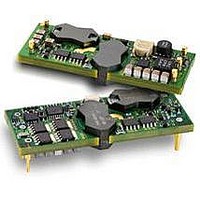PKB4713PINB Ericsson Power Modules, PKB4713PINB Datasheet - Page 39

PKB4713PINB
Manufacturer Part Number
PKB4713PINB
Description
Module DC-DC 1-OUT 12V 6A 72W 8-Pin 1/8-Brick
Manufacturer
Ericsson Power Modules
Series
PKBr
Datasheet
1.PKB4418PINB.pdf
(46 pages)
Specifications of PKB4713PINB
Package
81/8-Brick
Product
Isolated
Output Power
72 W
Input Voltage Range
36 V to 75 V
Number Of Outputs
1
Output Voltage (channel 1)
12 V
Output Current (channel 1)
6 A
Isolation Voltage
2.25 KV
Package / Case Size
Eighth Brick
Output Type
Isolated
Lead Free Status / Rohs Status
Lead free / RoHS Compliant
Available stocks
Company
Part Number
Manufacturer
Quantity
Price
Part Number:
PKB4713PINB
Manufacturer:
ERICSSON/爱立信
Quantity:
20 000
Company:
Part Number:
PKB4713PINBLA
Manufacturer:
YHT
Quantity:
12 000
Operating information
Input Voltage
The input voltage range 36 to 75Vdc meets the requirements
of the European Telecom Standard ETS 300 132-2 for normal
input voltage range in —48 and —60 Vdc systems, -40.5 to -
57.0 V and —50.0 to -72 V respectively.
At input voltages exceeding 75 V, the power loss will be
higher than at normal input voltage and T
absolute max +110°C. The absolute maximum continuous
input voltage is 80 Vdc.
Turn-off Input Voltage
The DC/DC converters monitor the input voltage and will turn
on and turn off at predetermined levels.
The minimum hysteresis between turn on and turn off input
voltage is 3V.
Remote Control (RC)
The maximum required sink current is 1 mA. When the RC pin
is left open, the voltage generated on the RC pin is around
6 V. The second option is “positive logic” remote control,
which can be ordered by adding the suffix “P” to the end of
the part number. The converter will turn on when the input
voltage is applied with the RC pin open. Turn off is achieved
by connecting the RC pin to the - In. To ensure safe turn off
the voltage difference between RC pin and the - In pin shall
be less than 1V. The converter will restart automatically when
this connection is opened.
See Design Note 021 for detailed information.
Input and Output Impedance
The impedance of both the input source and the load will
interact with the impedance of the DC/DC converter. It is
important that the input source has low characteristic
impedance. The converters are designed for stable operation
without external capacitors connected to the input or output.
The performance in some applications can be enhanced by
addition of external capacitance as described under External
Decoupling Capacitors. If the input voltage source contains
significant inductance, the addition of a 100 µF capacitor
across the input of the converter will ensure stable operation.
The capacitor is not required when powering the DC/DC
converter from an input source with an inductance below
10 µH.
Prepared (also subject responsible if other)
EJUNGYA
Approved
SEC/D (Julia You)
PKB 4000 series
DC/DC converters, Input 36-75 V, Output 30 A/90 W
The products are fitted with a
remote control function referenced
to the primary negative input
connection (- In), with negative and
positive logic options available. The
RC function allows the converter to
be turned on/off by an external
device like a semiconductor or
mechanical switch. The RC pin has
an internal pull up resistor to Vcc
pin of controller IC.
ref
must be limited to
Checked
ESHUHAN
PRODUCT SPECIFICATION
No.
3/1301-BMR 636 Uen
Date
2008-1-11
External Decoupling Capacitors
When powering loads with significant dynamic current
requirements, the voltage regulation at the point of load can
be improved by addition of decoupling capacitors at the load.
The most effective technique is to locate low ESR ceramic
and electrolytic capacitors as close to the load as possible,
using several parallel capacitors to lower the effective ESR.
The ceramic capacitors will handle high-frequency dynamic
load changes while the electrolytic capacitors are used to
handle low frequency dynamic load changes. Ceramic
capacitors will also reduce any high frequency noise at the
load.
It is equally important to use low resistance and low
inductance PCB layouts and cabling.
External decoupling capacitors will become part of the
control loop of the DC/DC converter and may affect the
stability margins. As a “rule of thumb”, 100 µF/A of output
current can be added without any additional analysis. The
ESR of the capacitors is a very important parameter. Power
Modules guarantee stable operation with a verified ESR value
of >10 mΩ across the output connections.
For further information please contact your local Ericsson
Power Modules representative.
Output Voltage Adjust (V
The DC/DC converters have an Output Voltage Adjust pin
(V
or below Output voltage initial setting.
When increasing the output voltage, the voltage at the output
pins (including any remote sense compensation ) must be
kept below the threshold of the over voltage protection, (OVP)
to prevent the converter from shutting down. At increased
output voltages the maximum power rating of the converter
remains the same, and the max output current must be
decreased correspondingly.
To increase the voltage the resistor should be connected
between the V
Output voltage adjust function is according to information
given under the Output section for the respective product.
To decrease the output voltage, the resistor should be
connected between the V
adj
). This pin can be used to adjust the output voltage above
adj
pin and +Sense pin. The resistor value of the
Technical Specifi cation
EN/LZT 146 394 R5A August 2009
© Ericsson AB
Rev
A
adj
adj
)
pin and —Sense pin.
Reference
2 (5)
39















